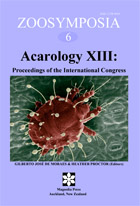Abstract
Fire is a natural disturbance factor in southern African grasslands, and has become an important management tool for conservation of these habitats. Information on the impact of fire on any aspect of biodiversity will assist land managers to make more informed decisions on a fire regime that will conserve biodiversity in these grasslands. This is the first study to examine the responses of mite assemblages to fire disturbance in South African grasslands. The study was conducted in the Erfenis Dam Nature Reserve in central South Africa. An area of the Reserve was burned with a fast, hot fire while another area was left unburned as a control. Soil oribatid mites were collected over a period of one year from the burned and control areas. Oribatid assemblages exhibited seasonal patterns, with species richness and abundance slightly higher in early and late autumn and early spring. Four months after fire, there was no residual effect of fire on total abundance and species richness. However, species composition and the seasonal relative abundances of particular species, e.g. Multioppia wilsoni Aoki, 1964, Scheloribates confusia Coetzer, 1968 and Anellozetes auriculatus (Mahunka, 1984), differed between burned and control plots, demonstrating how targeted species can be investigated as indicators of post-fire recovery.

